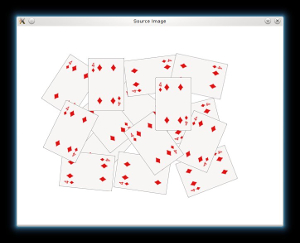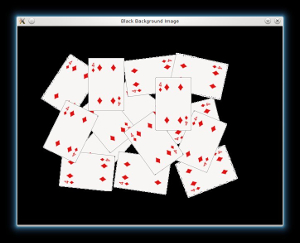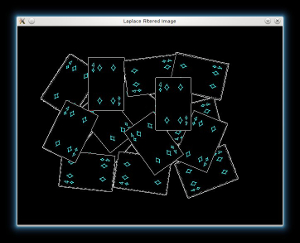// 加载图像
// 成功加载
if (!src.
data)
return -1;
// 显示图像
imshow(
"Source Image", src);

如果我们用白色背景图像,转换它的黑色是好的。这将有助于我们desciminate(discriminate 区分)前景对象时更容易,运用距离变换。
//改变背景颜色白色到黑色。 距离变换更方便。
for(
int x = 0; x < src.rows; x++ ) {
src.at<
Vec3b>(x, y)[0] = 0;
src.at<
Vec3b>(x, y)[1] = 0;
src.at<
Vec3b>(x, y)[2] = 0;
}
}
}
// 现实输出图像
imshow(
"Black Background Image", src);

// Create a kernel that we will use for accuting/sharpening our image 滤波
Mat kernel = (
Mat_<float>(3,3) <<
1, 1, 1,
1, -8, 1,
1, 1, 1);
// an approximation of second derivative, a quite strong kernel 二阶导数 一个强的核
// do the laplacian filtering as it is
// well, we need to convert everything in something more deeper then CV_8U
// because the kernel has some negative values, 负值
// and we can expect in general to have a Laplacian image with negative values
// BUT a 8bits unsigned int (the one we are working with) can contain values from 0 to 255
// so the possible negative number will be truncated
//因为内核有一些负值,我们一般可以得到一个负值的拉普拉斯图像。
//但8bits unsigned int(我们的工作)可以包含0到255的值,因此可能负值将被截断
//但8bits unsigned int(我们的工作)可以包含0到255的值,因此可能负值将被截断
Mat imgLaplacian;
Mat sharp = src;
// copy source image to another temporary one
Mat imgResult = sharp - imgLaplacian;
// convert back to 8bits gray scale
imgLaplacian.convertTo(imgLaplacian,
CV_8UC3);
// imshow( "Laplace Filtered Image", imgLaplacian );
imshow(
"New Sharped Image", imgResult );
src = imgResult;
// copy back
// Create binary image from source image
Mat bw;
cvtColor(src, bw,
CV_BGR2GRAY);
imshow(
"Binary Image", bw);
// Perform the distance transform algorithm
//完成距离变换算法
Mat dist;
distanceTransform(bw, dist,
CV_DIST_L2, 3);
// Normalize the distance image for range = {0.0, 1.0}
// so we can visualize and threshold it
normalize(dist, dist, 0, 1.,
NORM_MINMAX);
imshow(
"Distance Transform Image", dist);

//灰度图像和二值图像转化
// Threshold to obtain the peaks
// This will be the markers for the foreground objects
threshold(dist, dist, .4, 1.,
CV_THRESH_BINARY);
// Dilate a bit the dist image
dilate(dist, dist, kernel1);
imshow(
"Peaks", dist);
// Create the CV_8U version of the distance image
// It is needed for findContours()
Mat dist_8u;
// Find total markers
vector<vector<Point> > contours;
// Create the marker image for the watershed algorithm
// Draw the foreground markers
for (
size_t i = 0; i < contours.size(); i++)
drawContours(markers, contours, static_cast<int>(i), Scalar::all(static_cast<int>(i)+1), -1);
// Draw the background marker
imshow(
"Markers", markers*10000);
// Perform the watershed algorithm
watershed(src, markers);
bitwise_not(mark, mark);
// imshow("Markers_v2", mark); // uncomment this if you want to see how the mark
// image looks like at that point
// Generate random colors
vector<Vec3b> colors;
for (
size_t i = 0; i < contours.size(); i++)
{
}
// Create the result image
// Fill labeled objects with random colors
{
{
if (index > 0 && index <= static_cast<int>(contours.size()))
else
}
}
// Visualize the final image
imshow(
"Final Result", dst);
waitKey(0);
return 0;
}





















 266
266











 被折叠的 条评论
为什么被折叠?
被折叠的 条评论
为什么被折叠?








